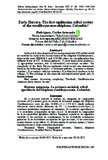| dc.rights.license | http://creativecommons.org/licenses/by-nc-sa/3.0/ve/ | es_VE |
| dc.contributor.author | Rodríguez, Carlos Armando | |
| dc.date.accessioned | 2022-11-22T14:37:04Z | |
| dc.date.available | 2022-11-22T14:37:04Z | |
| dc.date.issued | 2022-11-22 | |
| dc.identifier.uri | http://www.saber.ula.ve/handle/123456789/48631 | |
| dc.description.abstract | In this article, the categories of increasing complexity (CC) and threshold
are used for the study of the ancient history of the Altiplano Cundiboyacense,
between the years 20,000 B.C. and 1550 AD, where we can differentiate four
different levels of CC: 1) hunter-gatherers; 2) early hunter-food producers;
3) agro-pottery societies, and 4) hierarchical cacical-type societies. The
complexity of the Early Herrera egalitarian tribal society was determined,
based on the following variables: 1) settlement patterns, 2) primary economic
activities, 3) secondary craft-type activities, 4) architectural structures in the
villages, 5) The exchange of raw materials and manufactured goods and, 6)
funeral customs. | es_VE |
| dc.language.iso | es | es_VE |
| dc.publisher | SaberULA | es_VE |
| dc.rights | info:eu-repo/semantics/openAccess | es_VE |
| dc.subject | Increasing complexity | es_VE |
| dc.subject | Threshold | es_VE |
| dc.subject | Cundiboyacense altiplano | es_VE |
| dc.subject | Early Herrera society | es_VE |
| dc.title | Early Herrera. The first egalitarian tribal society of the cundiboyacense altiplano, Colombia | es_VE |
| dc.title.alternative | Herrera temprano. La primera sociedad tribal igualitaria del altiplano cundiboyacense, Colombia | es_VE |
| dc.type | info:eu-repo/semantics/article | es_VE |
| dcterms.dateAccepted | 07-10-2022 | |
| dcterms.dateSubmitted | 06-09-2022 | |
| dc.description.abstract1 | En el presente artículo se utilizan las categorías de complejidad
creciente (CC) y umbral, para el estudio de la historia antigua del Altiplano
Cundiboyacense, entre los años 20.000 a.C. y 1.550 d.C., donde podemos
diferenciar cuatro niveles diferentes de CC.: 1) cazadores-recolectores; 2)
cazadores-productores tempranos de alimentos; 3) sociedades agroalfareras,
y 4) sociedades jerarquizadas de tipo cacical. Se determinó la complejidad
de la sociedad tribal igualitaria Herrera Temprano, a partir de las siguientes
variables:1) los patrones de asentamiento, 2) las actividades econo´micas
primarias 3) las actividades secundarias de tipo artesanal, 4) las estructuras
arquitectónicas en las aldeas, 5) El intercambio de materias primas y bienes
manufacturados y, 6) las costumbres funerarias. | es_VE |
| dc.description.colacion | 249-289 | es_VE |
| dc.description.email | carlos.a.rodriguez@correounivalle.edu.co | es_VE |
| dc.description.frecuencia | Semestral | |
| dc.description.paginaweb | www.saber.ula.ve/boletin_antropologico | |
| dc.identifier.edepositolegal | ppi201403ME788 | |
| dc.identifier.eissn | 2542-3304 | |
| dc.publisher.pais | Venezuela | es_VE |
| dc.subject.institucion | Universidad de Los Andes | es_VE |
| dc.subject.keywords | Complejidad creciente | es_VE |
| dc.subject.keywords | Umbral | es_VE |
| dc.subject.keywords | Altiplano cundiboyacense | es_VE |
| dc.subject.keywords | Sociedad Herrera Temprano | es_VE |
| dc.subject.seccion | Boletín Antropológico: Artículos | es_VE |
| dc.subject.tipo | Artículos | es_VE |
| dc.type.media | Texto | es_VE |
| dc.identifier.doi | http://www.doi.org/10.53766/BA/2022.104.02.03 | es |
| dc.contributor.orcid | http://orcid.org/0000-0002-4765-9123 | |


